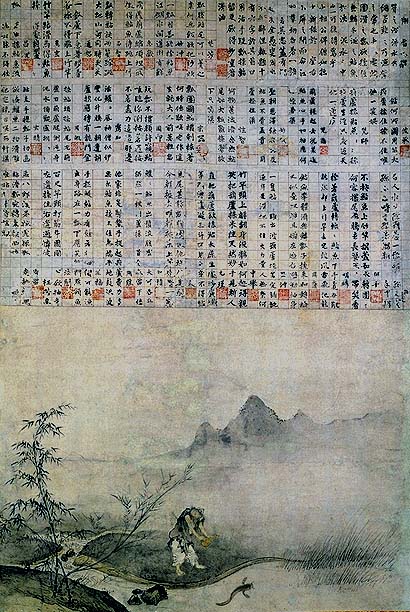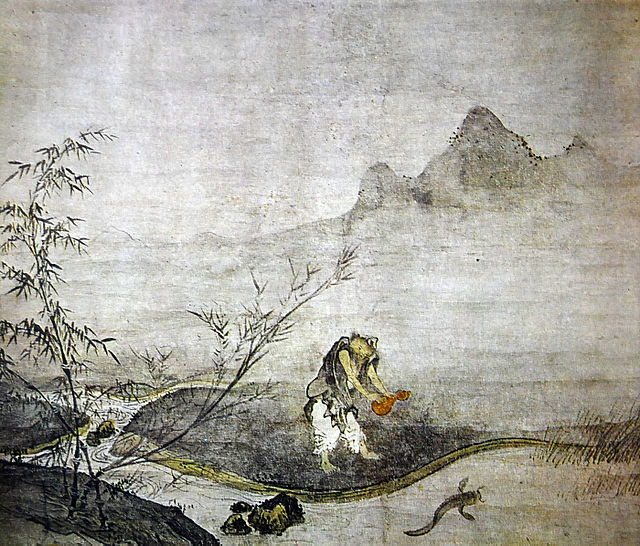ZEN MESTEREK ZEN MASTERS
« Zen főoldal
« vissza a Terebess Online nyitólapjára
如拙 Josetsu (fl. 1405–1496)
Josetsu
http://en.wikipedia.org/wiki/Josetsu
Josetsu (如拙 fl. 1405–1496) was one of the first suiboku style Zen Japanese painters in the Muromachi Period (15th century). He was probably also a teacher of Tenshō Shūbun (天章周文, 1414-1463) at the Shōkoku-ji monastery in Kyoto. A Chinese immigrant, he was naturalised in 1370 and is known as "the father of Japanese ink painting". The best known of his paintings belongs to Taizō-in, a sub-temple of Myōshin-ji in Kyoto, which is entitled Catching a Catfish with a Gourd (c.1413). It shows a comical-looking man fishing against a background of a winding river and a bamboo grove. It is thought to have been inspired by a riddle set by the Ashikaga shogun, "How do you catch a catfish with a gourd?" It can be viewed as a piece of Zen humour, or as a kōan in visual form designed to provoke the viewer into new ways of "seeing". Josetsu was an amazing figure in ink painting at that period of time and also influenced many painters as well.
A Mysterious Painting, Josetsu's Catching a Catfish with a Gourd
Text by Hideo Yamamoto, Department of Archives, Kyoto National Museum
English Translation by Melissa M. Rinne
First, take a look at the painting in the photo below.

National Treasure
Josetsu, Catching a Catfish with a Gourd
Ink and light colors on paper,
111.5 x 75.8 cm
Muromachi Period (15th Century)
(Taizo-in Temple, Kyoto)
The bottom of the painting shows a small river running into what looks like a march. Reeds grow in the shallow water and bamboo is growing on the bank. There seem to be tall mountains in the background , but there is so much mist or fog that we cant see them very well. There must be a lot of humidity there! In the center of the painting stands the shabby looking figure of a man. His face is covered with whiskers and his clothes are ragged, but what is even more curious is the fact that he is carrying a gourd with both hands! Still stranger yet is that he is holding his gourd down towards an enormous catfish in the water below! What on earth could this man be doing? And what could possibly be the topic of this work? This is truly a mysterious and one-of-a-kind painting!
It is not only the strange scene on the bottom half that makes this painting unique, but also the writing above! It may be hard to see, but what is written across the top in three rows (reading from top to bottom, moving from right to left) are poems! Do you see the red seal at the end of each poem? In the Muromachi Period (1392-1568) when this was painted, it was common practice to write poetry at the top of paintings, so it is not the poetry itself that is unusual. In fact, what makes this painting special is the great number of poems written above the picture! Most paintings had only one or two poems at the top, and at the most, a painting might have up to ten or fifteen poems. This painting, however, has thirty-one poems, and each is written by a different poet! What's more, the poets are all top-level priests from Zen temples in Kyoto in the 15th Century! With its mysterious subject matter and plethora of poems, I think you can see how very unusual this painting really is!
Fortunately, along with the poems at the top of the painting is an introduction that tells us that this work is based on the topic "How do you catch a catfish with a gourd?" The person who came up with this theme was the 4th Shogun of the Muromachi Period, Ashikaga Yoshimochi (1386-1428). Upon Yoshimochi's orders, the priest/artist Josetsu painted the scene below, and the highest-ranking Zen priests in Kyoto tried to answer the riddle in the poems above. Aha, that explains the peculiar subject matter! And if they were ordered by the Shogun, it makes sense that the most important Zen priests of the day would have agreed to write the poetry at the top!
However, is it really possible to catch a catfish with a gourd? Of course not! There is no way that one could catch a slick and slippery catfish with a smooth gourd! Perhaps the creator of the riddle Yoshimochi wasn't hoping for a correct answer... Instead Yoshimochi's purpose in providing such a difficult question was probably to have fun thinking together about the answer with the wise and witty high priests! The subject of the painting seems to be a derivation of the old Chinese saying, "a catfish climbs up through a bamboo pole," which means "to work very hard at something and finally succeed," or "to do the impossible." This theme of "catching a catfish with a gourd" simply added a gourd to this ancient theme. Catfish and bamboo (remember that there are bamboo trees in this painting) have something in common: they are both smooth and slippery. The smooth gourd contributes to this slippery theme! In any case, this question was made to tease the brain, a sort of an intellectual Zen game!

瓢鮎図 Hyônen zu (Catching cat-fish with a gourd)
Though they must have enjoyed it, Josetsu and the other priests went about their work with a sense of purpose. First of all Josetsu emphasized the "slippery" theme in the painting by giving curved lines to the catfish, the gourd, the bamboo, the flow of the river, and the riverbank. Can you see how they all have smooth S-curves? Then in contrast to the slippery curves, he painted the raggedy man holding the gourd in a ridiculously stiff and angular position. With this, Josetsu skillfully made the man's actions seem even more silly!
The priests also used hidden techniques in their poetry to bring the work together. Though each poem seems to express individual thoughts on the theme of "catching a catfish with a gourd," it is actually somehow "linked" to the next verse. This means that the priests used a complicated literary technique to link each poem to the next, a sort of a literary game!
The introduction tells us that "The theme given to us by Yoshimochi has a very deep meaning," but don't be fooled into thinking about this too seriously! The priests were undoubtedly trying not to giggle as they wrote their poems, and when the Shogun Yoshimochi read their work, he must have rolled with laughter!
The poems and painting in this work show us how very free indeed was the atmosphere surrounding the Shogun Yoshimochi. Josetsu's Catching a Catfish with a Gourd is one of the great masterpieces of Muromachi ink painting!
![]() Japanese Zen Buddhism and the Impossible Painting
Japanese Zen Buddhism and the Impossible Painting
Lecture by Professor Yukio Lippit
September 23, 2014, The Getty Center
https://www.youtube.com/watch?v=iLTpYPM3smU
![]()
如拙 Josetsu (1405–1496): 瓢鮎図 Hyônen zu
Harcsafogás tökhéj kulaccsal